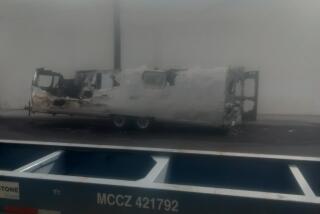Healing New Battle Scars of Old Plane
- Share via
In a hangar at Van Nuys Airport, a relic of World War II conjures up images of machine gun fire, shot-up planes smashing into U.S. warships and kamikaze pilots crashing into the sea.
Aviation experts say only half a dozen Japanese-made Mitsubishi Zeros are left, and one of them, a 1943 model, is being repaired by airplane mechanic Peter Regina in Van Nuys. With 900 horsepower and the ability to travel 300 mph, the lightweight and highly maneuverable Zero was a force to reckon with in the Pacific skies.
“It was hard to stop. Until the U.S. Hellcat came out, nothing could really compete with them,” Regina said Tuesday. “They were a real scourge in the Pacific.”
The F6F Hellcat, which was manufactured by Grumman and went into service in 1943, was faster and had more firepower than the Zero, Regina said.
Regina expects the $3-million plane to be flying in three months after completion of $85,000 in repairs, which are covered by insurance.
“I’m going to fly it when it’s done,” said the mechanic, who specializes in restoring and repairing planes from the 1940s and ‘50s. “It’s going to be more like a sport car than a fighter plane.”
The plane’s landing gear was damaged in April while on location for a movie shoot on Ford Island in Hawaii. The Touchstone film, tentatively titled “Pearl Harbor,” is scheduled to be released next year.
The Zero will then be returned to the Museum of Flying in Santa Monica, which owns it.
Zeros, the main Japanese fighter plane during World War II, took part in the attack on Pearl Harbor and fought in the Battle of Midway, said Tony Beres, curator at the San Diego Aerospace Museum. The museum has a Zero with an original Japanese engine, but it’s not flyable.
Japan built more than 10,000 Zeros, starting in 1939, Beres said. Most were destroyed or dismantled for scrap metal after the war, Regina said.
American pilots were discouraged from tailing the single-engine planes because they could easily turn on the pursuers, he said.
“The Japanese just about beat us in the Pacific with this airplane,” Beres said. “You didn’t get into a turn with them because they could out turn you.”
The single-engine aluminum planes were designed to fly long distances, as much as 620 nautical miles, before refueling. “It sacrificed armor and self-fueling tanks for the long range,” Beres said.
Unlike American and British planes, the Zero had no rubber coating on its tanks to protect them from gunfire. The magnesium in the plane’s construction and its unprotected tanks made the aircraft susceptible to fire after being hit, Beres said.
But if the Zeros were not hit first, they could do serious damage with two 7.7-millimeter machine guns that shot through the propeller and two 20-millimeter guns attached to the wings.
“They were pretty devastating,” said Regina, 53, of Granada Hills. “They could shoot down other planes and sink small ships.”
The Zero at Van Nuys is decorated with dummy guns, but the cockpit instruments are the originals. The plane, full of corrosion and bullet holes, was found in overgrown jungle on an abandoned Japanese airfield in New Guinea in 1985, Regina said.
The plane, which weighs about 5,800 pounds, was restored but has an American engine. Last week, Regina picked it up at North Island Naval Station in San Diego and brought it to his shop at Van Nuys Airport during two trips. Three mechanics, including Regina, will fix the plane’s bent propeller, rebuild its wing flaps, replace the left wing tip and touch up its paint.
“It will look nice when it’s done,” Regina said. One mechanic “said it’s going right back to zero.”
More to Read
Sign up for Essential California
The most important California stories and recommendations in your inbox every morning.
You may occasionally receive promotional content from the Los Angeles Times.













